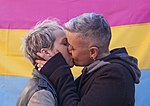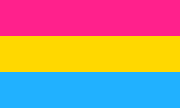
Romantic orientation, also called affectional orientation, is the classification of the sex or gender which a person experiences romantic attraction towards or is likely to have a romantic relationship with. The term is used alongside the term "sexual orientation", as well as being used alternatively to it, based upon the perspective that sexual attraction is only a single component of a larger concept.

Bi-curious is a term for a person, usually someone who is a self-identified heterosexual, who is curious or open about engaging in sexual activity with a person whose sex differs from that of their usual sexual partners. The term is sometimes used to describe a broad continuum of sexual orientation between heterosexuality and bisexuality. Such continuums include mostly heterosexual or mostly homosexual, but these can be self-identified without identifying as bisexual. The terms heteroflexible and homoflexible are mainly applied to bi-curious people, though some authors distinguish heteroflexibility and homoflexibility as lacking the "wish to experiment with sexuality" implied by the bi-curious label. It is important when discussing this continuum to conclude that bisexuality is distinct from heterosexuality and homosexuality rather than simply an extension of said sexualities like the labels heteroflexibility and homoflexibility would imply, due to the prominent erasure and assimilation of bisexuality into other identity groups. To sum it up, the difference between bisexual and bicurious is that bisexual people know that they are sexually attracted to both genders based on personal experience. Bicurious people are still maneuvering their way through their sexuality.

LGBT is an initialism that stands for "lesbian, gay, bisexual, and transgender". It may refer to anyone who is non-heterosexual, non-heteroromantic, or non-cisgender, instead of exclusively to people who are lesbian, gay, bisexual, or transgender. A variant, LGBTQ, adds the letter Q for those who identify as queer or are questioning their sexual or gender identity. Another variation, LGBTQ+, adds a plus sign "represents those who are part of the community, but for whom LGBTQ does not accurately capture or reflect their identity". Many further variations of the acronym exist, such as LGBT+, LGBTQIA+, and 2SLGBTQ+. The LGBT label is not universally agreed to by everyone that it is generally intended to include. The variations GLBT and GLBTQ rearrange the letters in the acronym. In use since the late 1980s, the initialism, as well as some of its common variants, functions as an umbrella term for marginalized sexualities and gender identities.

The Kinsey scale, also called the Heterosexual–Homosexual Rating Scale, is used in research to describe a person's sexual orientation based on one's experience or response at a given time. The scale typically ranges from 0, meaning exclusively heterosexual, to a 6, meaning exclusively homosexual. In both the male and female volumes of the Kinsey Reports, an additional grade, listed as "X", indicated "no socio-sexual contacts or reactions" (asexuality). The reports were first published in Sexual Behavior in the Human Male (1948) by Alfred Kinsey, Wardell Pomeroy, and others, and were also prominent in the complementary work Sexual Behavior in the Human Female (1953).
Femme is a term traditionally used to describe a lesbian woman who exhibits a feminine identity or gender presentation. While commonly viewed as a lesbian term, alternate meanings of the word also exist with some non-lesbian individuals using the word, notably some gay men and bisexuals. Some non-binary and transgender individuals also identify as lesbians using this term.

Biphobia is aversion toward bisexuality or people who are identified or perceived as being bisexual. Similarly to homophobia, it refers to hatred and prejudice specifically against those identified or perceived as being in the bisexual community. It can take the form of denial that bisexuality is a genuine sexual orientation, or of negative stereotypes about people who are bisexual. Other forms of biphobia include bisexual erasure.
Sexual identity refers to one's self-perception in terms of romantic or sexual attraction towards others, though not mutually exclusive, and can be different to romantic identity. Sexual identity may also refer to sexual orientation identity, which is when people identify or dis-identify with a sexual orientation or choose not to identify with a sexual orientation. Sexual identity and sexual behavior are closely related to sexual orientation, but they are distinguished, with identity referring to an individual's conception of themselves, behavior referring to actual sexual acts performed by the individual, and sexual orientation referring to romantic or sexual attractions toward persons of the opposite sex or gender, the same sex or gender, to both sexes or more than one gender, or to no one.

Non-heterosexual is a word for a sexual orientation or sexual identity that is not heterosexual. The term helps define the "concept of what is the norm and how a particular group is different from that norm". Non-heterosexual is used in feminist and gender studies fields as well as general academic literature to help differentiate between sexual identities chosen, prescribed and simply assumed, with varying understanding of implications of those sexual identities. The term is similar to queer, though less politically charged and more clinical; queer generally refers to being non-normative and non-heterosexual. Some view the term as being contentious and pejorative as it "labels people against the perceived norm of heterosexuality, thus reinforcing heteronormativity". Still, others say non-heterosexual is the only term useful to maintaining coherence in research and suggest it "highlights a shortcoming in our language around sexual identity"; for instance, its use can enable bisexual erasure.
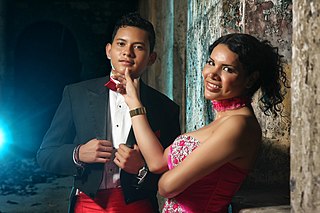
Sexual attraction to transgender people has been the subject of scientific study and social commentary. Psychologists have researched sexual attraction toward trans women, trans men, cross dressers, non-binary people, and a combination of these. Publications in the field of transgender studies have investigated the attraction transgender individuals can feel for each other. The people who feel this attraction to transgender people name their attraction in different ways.
The bisexual community, also known as the bi+, m-spec, bisexual/pansexual, or bi/pan/fluid community, includes members of the LGBT community who identify as bisexual, pansexual, omnisexual, polysexual and sexually fluid. As opposed to hetero- or homosexual people, people in the bisexual community experience attraction to more than one gender.

A pride flag is any flag that represents a segment or part of the LGBT community. Pride in this case refers to the notion of LGBT pride. The terms LGBT flag and queer flag are often used interchangeably.

Bisexual erasure, also called bisexual invisibility, is the tendency to ignore, remove, falsify, or re-explain evidence of bisexuality in history, academia, the news media, and other primary sources.

The questioning of one's sexual orientation, sexual identity, gender, or all three is a process of exploration by people who may be unsure, still exploring, or concerned about applying a social label to themselves for various reasons. The letter "Q" is sometimes added to the end of the acronym LGBT ; the "Q" can refer to either queer or questioning.
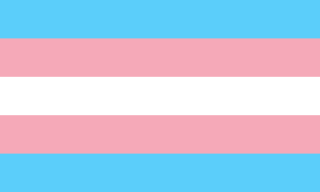
A transgender person is someone whose gender identity differs from that typically associated with the sex they were assigned at birth. Some transgender people who desire medical assistance to transition from one sex to another identify as transsexual. Transgender is also an umbrella term; in addition to including people whose gender identity is the opposite of their assigned sex, it may also include people who are non-binary or genderqueer. Other definitions of transgender also include people who belong to a third gender, or else conceptualize transgender people as a third gender. The term may also include cross-dressers or drag kings and drag queens in some contexts. The term transgender does not have a universally accepted definition, including among researchers.

Bisexuality is a romantic or sexual attraction or behavior toward both males and females, to more than one gender, or to both people of the same gender and different genders. It may also be defined to include romantic or sexual attraction to people regardless of their sex or gender identity, which is also known as pansexuality.
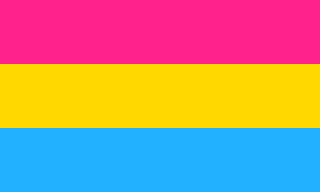
The pansexual flag is a pink, yellow and cyan flag, designed as a symbol for the pansexual community to increase its visibility and recognition, and distinguish itself from bisexuality.

The following outline offers an overview and guide to LGBT topics.
LGBT erasure refers to the tendency to intentionally or unintentionally remove LGBT groups or people from record, or downplay their significance, which includes lesbian, gay, bisexual, transgender people and those who identify as queer. This erasure can be found in a number of written and oral texts, including popular and scholarly texts.
The portrayals of pansexuality in the media reflect existing societal attitudes towards pansexuality and current media portrayals. Although pansexual characters are not often characters in mass media, they have appeared in various films, TV series, literature, video games, graphic art, and webcomics, sometimes embodying certain tropes in cinema and fantasy. Musicians, actors, and other public personalities have also, in recent years, come out as pansexual, and are focused on with this page.

Plurisexuality or multisexuality is a term used to describe individuals who are attracted to multiple genders. This includes certain sexual identities such as pansexuality, bisexuality, omnisexuality, and polysexuality, falling under the umbrella of non-monosexuality, which encompasses all sexualities that are not exclusively heterosexual or homosexual. It's also referred as multiple-gender attraction (MGA). Plurisexual individuals may experience sexual attraction to people of different genders, which can include but is not limited to men, women, non-binary, genderqueer, and other gender identities. Plurisexuality can be fluid and may vary from person to person. Abrosexual, for example, can be used to describe when one's experience changes in their attractions over time.
